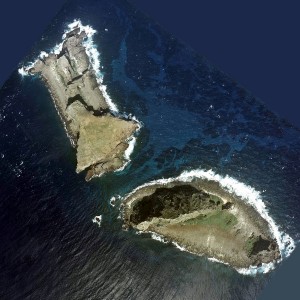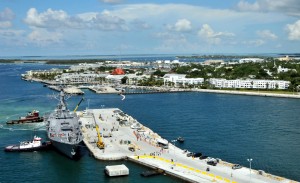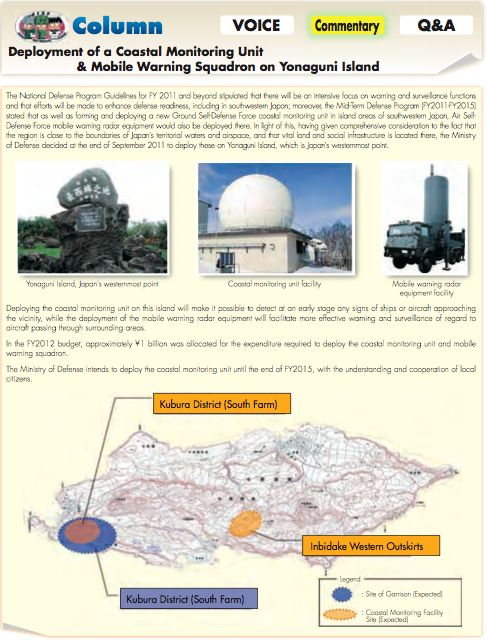 Despite all the handwringing over Japan’s overly-bellicose-for-Western-tastes speechmaking, everyone rational should all welcome Japan’s public announcement that the southernmost tip of the Ryukyu/Nansei island chain, Yonaguni Island, will–in a few years–be home to a 150-soldier surveillance base.
Despite all the handwringing over Japan’s overly-bellicose-for-Western-tastes speechmaking, everyone rational should all welcome Japan’s public announcement that the southernmost tip of the Ryukyu/Nansei island chain, Yonaguni Island, will–in a few years–be home to a 150-soldier surveillance base.
Frankly, this sort of facility is long overdue
Surveillance adds stability to the region.
We all know China likes to operate unobserved, and prefers to present the world with their latest “newly-seized reef” or “destabilized border” as a fait accompli. Good ISR helps keep China honest, and will help stabilize the disputed Senkaku Island zone.
So, of course China is going to hate any step to inject additional ISR resources into the region. (And, for that matter, so will a few island locals–who earned their keep in the smuggling trade)
But if you read, oh, RT, Al Jazzera and the Guardian, you’d be excused if you thought China was now obligated to start operations to liberate Yonaguni Island–to heck with territorial integrity! After all, the island is, as RT.Com helpfully tells us, “far closer to China and Taiwan than it is to Japan’s major isles.”
Here are some of their hand-wringing reviews:
RT: “Tokyo is likely to provoke wrath from Beijing after starting work on a new radar station close to the disputed Senkaku, or Diaoyu Islands…”
Al Jazzera: ” Local anger and Japan Island surveillance unit: Residents scuffle with officials as Tokyo begins construction of coastal monitoring unit near islands claimed by China.”
The Guardian: “Japan risks angering China with military expansion:….:The Japanese defence minister, Itsunori Onodera: “This is the first deployment since the US returned Okinawa in 1972 and calls for us to be more on guard are growing”
To help see though the hype (and Onodera’s rhetoric), consider Yonaguni Island Japan’s equivalent to Key West, Florida. Just as Key West is 90-100 miles from that dangerous hive of cigar-makers–Havana, Cuba–Yonaguni is 90-100 miles from the contested Senkaku Islands–and Taiwan.
So…what can one glean from that rather forced analogy? Well, to put it into an American frame of reference, Japan has essentially announced that, despite being in the midst of a Cuban Missile Crisis-like situation, the Japanese Self Defense Forces will, in a few years, put a radar in their Key West.
Now, that’s not exactly a Kennedy-esque response, is it? Even President Carter–in his peaceful, present-day dotage–would probably chose to move faster than Japan.
 When roles were reversed, and the US faced a threat 90 miles from our south-easternmost point, Key West almost sank under the weight of all the military gear placed there.
When roles were reversed, and the US faced a threat 90 miles from our south-easternmost point, Key West almost sank under the weight of all the military gear placed there.
Even today, with few viable hazards beyond the occasional Russian intel-gathering tug, Key West is still host to an enormous array of military facilities–Joint Interagency Task Force South (a funky anti-smuggling, anti-crime, anti-Cuba spook house), Coast Guard Sector Key West, U.S. Army Special Forces Underwater Operations School, and Naval Air Station Key West (Boca Chica!). Add in a surveillance Aerostat mooring-point, Truman Harbor, and sufficient extra berthing-space for a CVN (if the Cruise Ships can moor there, then, why not a CVN in a pinch?) and a few other interesting odds and ends, Key West remains an awfully militarized corner of the nation.
So, while Yonaguni may not be able to be host to all those things, it certainly has–if Japan wishes–the potential to become something of an armed camp. To Japan’s credit, they have resisted adding military forces to the place for far longer then they probably should have (despite being a known smuggling conduit, the place currently only hosts two (count ’em) policemen). Yonaguni deserves more than two patrolmen, and the southern Ryukyus/Nanseis certainly merit more than just a radar station and a southward redeployment of E-2C surveillance planes to Okinawa.
Sigh. Aside from the unfortunate “deployment” chest-thumping from Onodera (which, in my assessment, isn’t exactly true. Japanese SDF personnel took over Marcus Island’s LORAN-C navigation station in 1993, and the SDF opened few new domestic bases in various spots over the last few years.), a radar station was a long-expected.
The real question was when Japan would get around to it. Despite talking about Ryukyus vulnerability for YEARS (I add a screen grab from one of Japan’s excellent Defense White Papers-2012–for review), Japan has really dragged it’s feet over injecting some military resources onto Yonaguni and the lower Ryukyus, and THAT, in my assessment, has done far more to destabilize things than overt militarization would have.
With China, good, well-tended fences make good neighbors. Un-attended ones…well, talk to India and the Philippines and Vietnam….and even Russia.
It would certainly be nice to leave the lower Ryukyus as they are–an out of the way place for smugglers and, oh, a reincarnated Japanese version of Ernest Hemingway, but, alas, nationalism intervenes.

